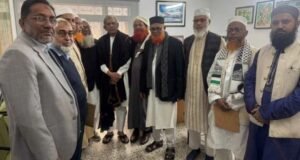 The Indian government has asked the army to start massive operations against the Khaplang faction of the National Socialist Council of Nagaland (NSCN) and its allies in a new anti-Indian rebel front.
The Indian government has asked the army to start massive operations against the Khaplang faction of the National Socialist Council of Nagaland (NSCN) and its allies in a new anti-Indian rebel front.
Indian Defence Minister Manohar Parikkar, Home Minister Rajnath Singh and National Security Adviser Ajit Doval reviewed the situation with army chief General Dalbir Singh late on Thursday.
“We have asked the army to undertake massive operations to thwart the newly formed rebel coalition that calls itself UNLFWSEA. They are operating from their bases inside Myanmar and their attacks are becoming more serious,” a top Indian defence ministry official told bdnews24.com.
But no specifics for the ‘massive operations’ were provided, except that the Armed Forces Special Powers Act will not be lifted from any state of the region other than Tripura.
The left-ruled Tripura state has tackled tribal insurgency firmly and its chief minister Manik Sarkar says Bangladesh’s present government has been a great help.
So, it decided to lift the special act that gives security forces sweeping powers.
On Thursday, after 20 Indian soldiers of the 6th Dogra Regiment died in a rebel ambush in Chandel district of Manipur state, the NSCN (Khaplang faction) claimed responsibility for the attack.
A statement from the Khaplang group said “an elite unit” of its guerrillas and those from its Manipuri allies, KYKL and KCP, had carried out the attack to “uphold the cause of our sovereignty.”
The NSCN (Khaplang), like other factions of the NSCN, had maintained a ceasefire with India since 2000 until March this year.
The Indian government piled huge pressure on the Khaplang faction to stop sheltering other active northeast Indian rebel groups in its bases in Myanmar’s remote Sagaing region.
Khaplang refused and broke off the 14-year-old ceasefire.
A month later, on Apr 17, the Burmese Naga rebel chieftain from the Hemi tribe, set up an anti-Indian rebel coalition called the United National Liberation Front of Western South East Asia (UNLFWSEA).
It was immediately joined by several other groups, the strongest being those from Manipur.
In the last two months, the UNLFSWEA forces led by Khaplang’s fighters have carried out six attacks on Indian army and para-military troops in three states – Nagaland, Manipur and Arunachal Pradesh – along India’s long border with Myanmar.
Thirty-five soldiers have died and many more have been injured in the attacks.
“Khaplang is trying to prove it remains a factor India cannot overlook. He may have been marginalised in the Naga political process with other NSCN factions made up of Indian Nagas vowing to fight him, but he has allies in states like Assam and Manipur. With their help, he can stage attacks in Indian territory,” said Samir Kumar Das, who has written extensively on Northeastern insurgencies.
Khaplang’s safe bases in Myanmar may become a sore point in India-Myanmar relations.
In 2012, Khaplang signed a peace deal with the Thein Sein government to avoid hostilities with the Tatmadaw.
The ceasefire has held unlike the one with India.
A report in the ‘Times of India’ sourced to top intelligence officials have alleged that Khaplang is now in Yangon undergoing medical treatment in government supported facility even as his fighters wreak havoc in the hills of northeast India.
Other reports suggest Khaplang has acquired a huge new arsenal of Chinese weapons through Wa and Kokang rebels close to Beijing , which is suspected of upping the ante in India’s northeast by bringing rebel armies onto a common platform as in Myanmar.
 Weekly Bangla Mirror | Bangla Mirror, Bangladeshi news in UK, bangla mirror news
Weekly Bangla Mirror | Bangla Mirror, Bangladeshi news in UK, bangla mirror news






